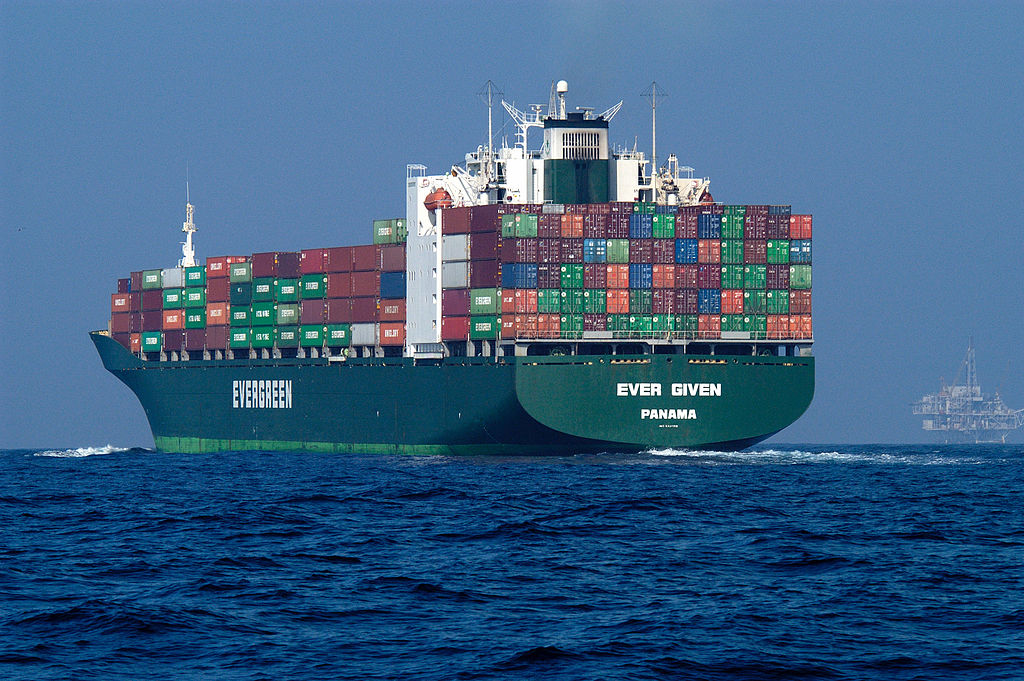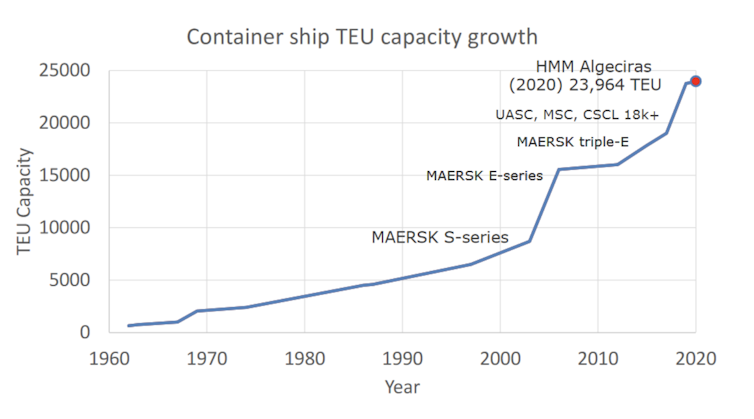The six-day blockage of the Suez Canal by a megaship named Ever Given came to an end on March 29 after salvage teams used dredging and tug boats to heave the vessel back into operation.
The capacity of a single vessel to block one of the world’s busiest shipping corridors, creating a traffic jam of hundreds of boats, has sparked a debate about the ever-growing size of megaships, with the Ever Given’s accident taken as evidence that they’ve simply become too large.
At 400 metres long, the Ever Given is indeed among the largest 1% of the world’s fleet. Its high-profile accident will result in a new wave of precautions to make megaships safer, but it will also prompt the shipping industry to reflect on whether such gigantic vessels actually do more harm than good.
Bigger boats
Container ships have been increasing in size for decades in order to carry more containers on each voyage. According to analysis from Allianz, the number of 20-foot containers that ships can carry has increased by 1,500% over the past 50 years.
One of the most significant size upgrades came when Maersk introduced its E-series in 2006, which can carry around 15,000 containers – doubling the capacity of the previous largest container ships.
In the 15 years since then, some 133 ships have been launched with a carrying capacity of between 18,000 and 24,000 containers. These are classed as ultra large container vessels – the biggest boats in the world. The Ever Given is one such vessel.
TEU stands for ‘twenty-foot equivalent units’ – the standard size of a single shipping container. Author provided
Economies of scale
Megaships are particularly attractive for international shipping firms because they offer economies of scale: the larger the ship, the more efficient it is at transporting goods.
The Ever Given can carry 20,000 containers, while so-called very large containerships can carry a maximum of just 9,000 containers. Using just one vessel instead of two to carry the same load saves fuel, significantly reduces the cost of transportation per container, and reduces the ship’s environmental footprint.
When megaships were first introduced, there were doubts about whether they’d actually use their huge carrying capacity. But evidence suggests they do: the Ever Given was reportedly carrying more than 18,000 containers when it became wedged in the Suez Canal. Unfortunately, carrying this many containers also has its downsides.
Megaship downsides
Operating megaships in confined waterways has already been shown to be difficult. Stacking them high with containers doesn’t help: it can lead the vessels to catch the wind and become even harder to control, which may have played a role in the Ever Given’s grounding.
When caught in a storm on open seas, such ships may also be more prone to losing containers overboard. According to recent analysis, at least five of the largest class of container ship lost containers during this year’s winter storm season in the Pacific.
Infrastructure is also struggling to cope with these larger ships. According to a 2015 report, ports, straits and canals require expansion to make way for the new class of megaships. The cost of such projects is immense: the expansion of the Panama Canal in 2016 to accommodate bigger ships ended up costing over $5 billion (£3.6 billion). In light of these infrastructural concerns, there may be an economic argument against expanding the number or size of megaships in our seas.
Size to blame?
An investigation is ongoing into the cause of the Ever Given’s accident, which should tell us to what extent her size was responsible. Based on previous incidents, strong winds, malfunctioning machinery and even human error could equally be to blame.
My research at the Maritime Safety Research Centre studies incidents such as this one, trying to understand the hazards and risks that may contribute to maritime accidents. When operational vessels run into trouble, we can learn from them to avoid accidents happening again.
If the Ever Given’s size was to blame for its accident, you’d expect other megaships, which have been transiting the Suez Canal for years, to have experienced similar difficulties. But a quick check of accident statistics shows that there are only two or three similar incidents involving megaships in the canal per year – out of 19,000 annual crossings.
In most cases, these are minor accidents causing little disruption, and they occur at such a low frequency that the Ever Given’s accident should not be interpreted as evidence that container ships have become too big.
But seeing as the consequences of the Ever Given’s accident were so severe, new maritime safety measures will rightly be put in place to avoid a similar incident happening in the future, such as ship design changes, better pilot training, the use of tug boats as canal escorts, autonomous guidance systems, and the widening of waterways.
Regardless of new safety measures, the Ever Given’s accident may well come to be regarded as a “black swan” event: an unpredictable one-off, rather than a sign of things to come. At present, there’s little evidence to suggest that container ships have become too big, or that the downsides of such megaships should result in their being scrapped.



 U.S. Dollar Slides for Third Straight Week as Rate Cut Expectations Boost Euro and Pound
U.S. Dollar Slides for Third Straight Week as Rate Cut Expectations Boost Euro and Pound  Modi and Trump Hold Phone Call as India Seeks Relief From U.S. Tariffs Over Russian Oil Trade
Modi and Trump Hold Phone Call as India Seeks Relief From U.S. Tariffs Over Russian Oil Trade  Brazil Holds Selic Rate at 15% as Inflation Expectations Stay Elevated
Brazil Holds Selic Rate at 15% as Inflation Expectations Stay Elevated  Wall Street Futures Slip as Oracle Earnings Miss Reignites AI Spending Concerns
Wall Street Futures Slip as Oracle Earnings Miss Reignites AI Spending Concerns  Hong Kong Cuts Base Rate as HKMA Follows U.S. Federal Reserve Move
Hong Kong Cuts Base Rate as HKMA Follows U.S. Federal Reserve Move  Global Forex Markets Brace for Fed Decision as Yen Extends Weakness
Global Forex Markets Brace for Fed Decision as Yen Extends Weakness  Oil Prices Rebound in Asia as Venezuela Sanctions Risks Offset Ukraine Peace Hopes
Oil Prices Rebound in Asia as Venezuela Sanctions Risks Offset Ukraine Peace Hopes  Stocks Slip as Investors Brace for Fed Decision and JPMorgan Warning Weighs on Markets
Stocks Slip as Investors Brace for Fed Decision and JPMorgan Warning Weighs on Markets  Gold Prices Hold Firm as Markets Await Fed Rate Cut; Silver Surges to Record High
Gold Prices Hold Firm as Markets Await Fed Rate Cut; Silver Surges to Record High  Gold Prices Dip as Markets Absorb Dovish Fed Outlook; Silver Eases After Record High
Gold Prices Dip as Markets Absorb Dovish Fed Outlook; Silver Eases After Record High  ADB Approves $400 Million Loan to Boost Ease of Doing Business in the Philippines
ADB Approves $400 Million Loan to Boost Ease of Doing Business in the Philippines  Asian Stocks Slip Ahead of Fed Decision as China Deflation Concerns Deepen
Asian Stocks Slip Ahead of Fed Decision as China Deflation Concerns Deepen  Oil Prices Edge Higher as U.S. Seizes Sanctioned Venezuelan Tanker
Oil Prices Edge Higher as U.S. Seizes Sanctioned Venezuelan Tanker  Mexico Moves to Increase Tariffs on Asian Imports to Protect Domestic Industries
Mexico Moves to Increase Tariffs on Asian Imports to Protect Domestic Industries  US Signals Openness to New Trade Deal as Brazil Shows Willingness, Says USTR Greer
US Signals Openness to New Trade Deal as Brazil Shows Willingness, Says USTR Greer  Ireland Limits Planned Trade Ban on Israeli Settlements to Goods Only
Ireland Limits Planned Trade Ban on Israeli Settlements to Goods Only  BOJ Expected to Deliver December Rate Hike as Economists See Borrowing Costs Rising Through 2025
BOJ Expected to Deliver December Rate Hike as Economists See Borrowing Costs Rising Through 2025 
































